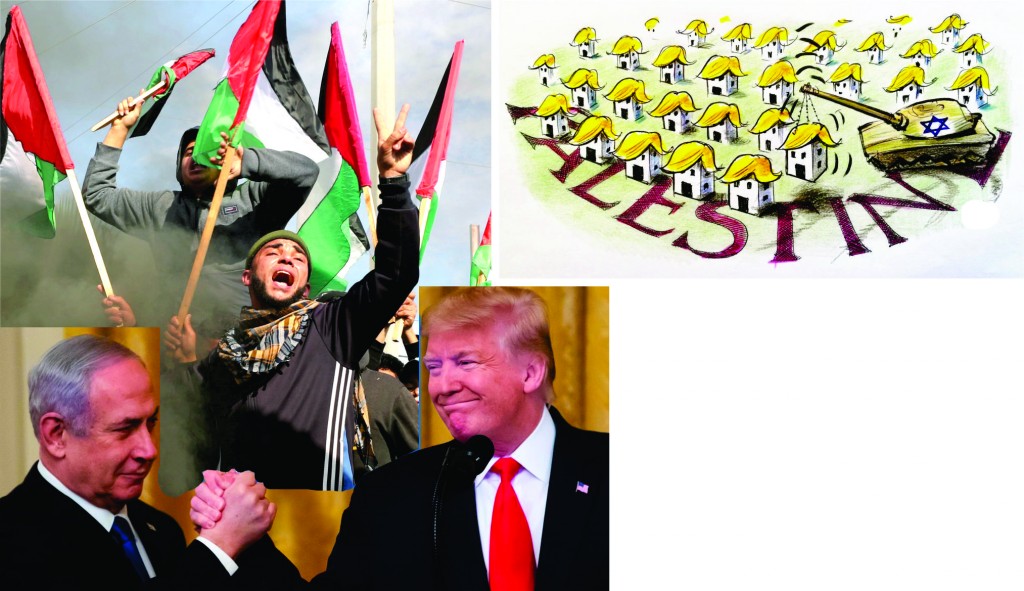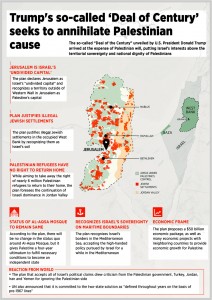‘DEAL OF THE CENTURY’
President Donald Trump very recently rolled out, in his usual flowery words, “the peace proposal of the century” in the US, strangely with only his good friend Israeli Prime Minister Benjamin Netanyahu by his side. He was assisted by his son-in-law Jared Kushner in chalking out the plan. Trump is volatile, simplistic and allegedly suffers from attention deficit disorder. It’s rather surprising that he took interest in the very complex Israel-Palestinian conflict and put such a heavy burden on his brain, especially after his ludicrous North Korea strides. Be that as it may, Israeli-Palestinian discord remains the central unresolved issue in the Middle East for many decades now. The matter is extremely complicated in its nature and its prospective solutions have an equally complex and very long backdrop.
midst much fanfare, US President Donald Trump officially unveiled his long-awaited “Deal of the Century”—the plan for resolving the century-old Palestinian-Israeli conflict—on January 28. Except for some additional details, the lengthy document did not add much to what had already been previously leaked about the deal. Yet, the content of it has already been widely criticised.
Jewish author Stephen Lendman described it as a “degrading spectacle” which “has nothing to do with peace, nothing to do with respect for Palestinians’ rights and welfare, everything to do with serving US/Israeli interests exclusively at the expense of regional peace and stability.” Even before the “official” unveiling, Peter Ford, former British ambassador to Bahrain and Syria and a senior official at the UN Agency for Palestinian Refugees until 2015 had this to say: “I don’t think this plan is serious at all. If you read the 96 pages of this plan, it reads like a real-estate prospectus for some utopian: maybe one of Donald Trump’s real estate developments or a new golf course, where the Palestinians perhaps would have jobs as caddies and green-keepers, looking after it for the Israeli owners of the territory.”
The Arab League, after concluding a meeting on the matter, unanimously rejected the plan, while reconfirming the Palestinians’ rights to statehood and liberation. The Organisation of Islamic Cooperation (OIC) also issued a similar rejection following a meeting in Jeddah, Saudi Arabia. The UN too has opposed the plan—reiterating that the Israeli-Palestinian conflict should be resolved based on UN resolutions and international law—as have many other world powers, in addition to credible Jewish voices in the US and in Israel. According to Hasan Abu Nimah, a retired Jordanian Ambassador, “the highly biased content of the deal confirms previous predictions that it was entirely authored in Israel by the most hardline extremist and racist settler elements there; the elements that openly claim Palestine as the land of the Jewish people with no place for the Palestinians in it.”
Disturbing historical parallels have been drawn between Palestinians and the Bantu people of South Africa by Sheena Anne Arackal, who specialises in the field of ethnic conflict. Ten territories were designated as quasi-autonomous states for the black African population during the mid to late 20th century and kept under control of the white supremacist state. The “Steal of the Century” is intended to bring about a similar fate for the Palestinians. The description of the proposal, which radiates racism and contempt for Palestinians, effectively denies that Palestinians were forced from their homes, ignores their right to their property and compensation, blames them for “terrorism” despite their (at least) 80:1 death rate with Israelis over the past decade.
What was revealed on January 28 is not a deal, or a peace proposal, or a plan, it is an endorsement of Israel’s extremist position that aims at eradicating the Palestinians from their homeland once and for all. Under President Trump’s peace plan, the Palestinians will be granted limited autonomy within a Palestinian homeland that consists of multiple non-contiguous enclaves scattered throughout the West Bank and Gaza. The government of Israel will retain security control over the Palestinian enclaves and will continue to control Palestinian borders, airspace, aquifers, maritime waters and electromagnetic spectrum. Israel will be allowed to annex the Jordan Valley and Jewish communities in the West Bank, while the Palestinians will be permitted to select the leaders of their new homeland but they will have no political rights in Israel, the state that actually rules over them. The plan, made by Jared Kushner, Trump’s son-in-law and advisor, David Friedman, US Ambassador to Israel, and Jason Greenblatt, Special Assistant to the President for International Negotiations, grants the Palestinian homeland autonomy over civil matters like education and healthcare, while keeping critical areas such as trade, immigration and security under Israeli control.
But the “miracle plan” has two parts, one with an economic and the other with a political focus. On the economic side, it talks about a USD 50 billion investment budget over the next 10 years, partly substituting USAID’s funding cuts from ongoing and future Gaza and Palestine development projects—so, hardly any new money. While Germany has paid at least USD 100 billion (so far) to the Jewish/Israeli communities as compensation for damages in World War II, Israel has yet to pay anything for its theft of nearly an entire country, the contents of homes and businesses and for the many thousands of those it murdered and maimed. To add insult to injury, the Palestinians will not be permitted to administer this funding: Israel, with its long history of skimming from the top of donations to Palestinians, will almost certainly administer any funding.
Under the Plan, the Palestinians would essentially recognise the illegally-built Israeli settlements, and give up any hope of rights to Jerusalem as a shared capital—Trump has already placed the US Embassy in Jerusalem to make sure there is no misunderstanding in regards to that. The deal says that Muslims wanting to visit their historic al-Aqsa Mosque must get Israeli permission. UNWRA, the United Nations Relief and Works Agency for Palestine Refugees in the Near East, would disappear. Other UN agreements and arrangements specially concluded in support of the discriminated Palestinian people would also be cancelled—all under the pretext that Palestine is now an autonomous state.
Not only was this sham of a “peace plan” made without the participation of Palestinians, but it also defies international law and international precedent on the issue and ignores Palestinian interests. Without question, by declaring Jerusalem Israel’s “undivided” capital, Trump has angered and pushed Palestinians away from coming to any sort of possible resolution to decades of violent conflict. Due to this proposal, Israel now has more of a reason to annex major illegal Israeli colonies in occupied West Bank.
The so-called “Vision for Peace” unveiled by Trump simply confirmed that the US government has publicly adopted the long-running consensus in Israel: that it is entitled to keep permanently the swathes of territory it seized illegally over the past half-century that deny the Palestinians any hope of a state. Importantly for Israel, it will get Washington’s permission to annex all of its illegal settlements, now littered across the West Bank, as well as the vast agricultural basin of the Jordan Valley, while Israel will continue to have military control over the entire West Bank.
Furthermore, the Trump administration appears to be considering giving a go-ahead to the Israeli Right’s long-held hopes of redrawing the current borders in such a way as to transfer potentially hundreds of thousands of Palestinians currently living in Israel as citizens into the West Bank. That would almost certainly amount to a war crime. The plan leaves no right of return for Palestinians, and it seems the Arab world will be expected to foot the bill for compensating millions of Palestinian refugees.
All of this has been dressed up as a “realistic two-state solution”, offering the Palestinians nearly 70 percent of the occupied territories—which in turn comprise 22 percent of their original homeland. Put another way, the Palestinians are being required to accept a state on 15 percent of historic Palestine after Israel has seized all the best agricultural land and the water sources.
As described by Bill Van Auken, the maps revealed along with the plan “show a patchwork of Palestinian cantons surrounded by Israeli territory, linked one to another by a series of Israeli-controlled bridges, tunnels and roads. The cantons themselves are peppered with what the plan describes as ‘Israeli enclave communities’, i.e. Zionist settlements that will be walled off, linked by apartheid-style Israeli-only security roads, and protected by Israeli security forces.” Imports and exports would have to pass through Israel, making the “cantons” vulnerable to possible Israeli siege. While over 140 countries have recognised Palestine, Palestinians would not be permitted to have any international treaties unless specifically approved by Israel, leaving them on their own and completely at the mercy of their tormentors.
Like all one-time deals, this patchwork “state”—lacking an army, and where Israel controls its security, borders, coastal waters and airspace—has an expiry date. It needs to be accepted within four years. Otherwise, Israel will have a free hand to start plundering yet more Palestinian territory.
But the truth is that neither Israel nor the US expects or wants the Palestinians to accept the deal. That is why the plan includes—as well as annexation of the settlements—a host of unrealisable preconditions before what remains of Palestine can be recognised: the Palestinian factions must disarm, with Hamas dismantled; the Palestinian Authority led by Mahmoud Abbas must strip the families of political prisoners of their stipends. And as Robert Fisk explained, “the belief that the Palestinians would dream of accepting such a deranged, farcical set of political demands is without precedent in the western world.”
The deal is most likely Trump telling his supporters that I am sticking to my campaign pledge of solving the Palestinian-Israeli conflict. However, it is not actually serious about solving the problem. But it does allow Trump to go back and say, we proposed a great deal, it is the Palestinians who rejected it—the same argument that the US and Israel have been sticking to now for decades.
For some critics, the timing of the declaration was seen as an opportunistic move to salvage two in-crisis leaders from problems they are facing at home—in fact, Netanyahu was indicted on corruption charges while in Washington awaiting the announcement ceremony of the deal. And to help Netanyahu in his battle in the third Israeli general election due on March 2, as well as Trump’s bid for a second presidential term at the end of this year. And, according to Hasan Abu Nimah, “Nothing could be more distressing than when the destiny of an entire people, the Palestinian people, is immorally, illegally and inhumanely utilised for such pure personal purposes.” However, that is what this Machiavellian game that the US and Israel are playing with the Palestinians is.
That is why the plan seems to have been designed intentionally in such a way that it is rejected by the Palestinians, so that they would be held responsible for missing another opportunity for peace and losing also their share as very poorly defined in the deal, the imagined Palestinian state, while the Israelis would then be free to grab most of the territory that it hasn’t already. Prime Minister Benjamin Netanyahu has announced his intention to bring just such an annexation plan before his cabinet as soon as possible.
 Jahangir's World Times First Comprehensive Magazine for students/teachers of competitive exams and general readers as well.
Jahangir's World Times First Comprehensive Magazine for students/teachers of competitive exams and general readers as well.



